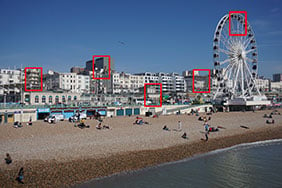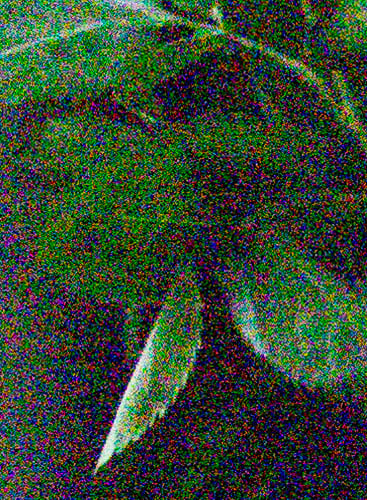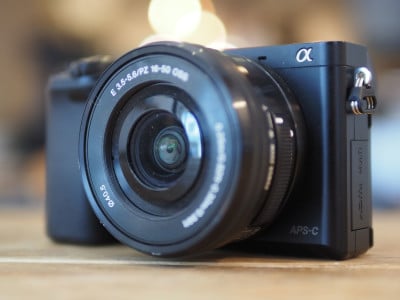Sony Alpha A6000 review
-
-
Written by Gordon Laing
Quality
Sony Alpha A6000 vs Olympus OMD EM5 JPEG

To compare real-life performance I shot this scene with the Sony Alpha A6000 and Olympus OMD EM5 within a few moments of each other using their RAW+JPEG modes; A6000 RAW results follow on the next page.
The A6000 was fitted with the 16-50mm f3.5-5.6 kit zoom and the EM5 fitted with the 12-50mm f3.5-6.3 kit zoom, both set to f5.6 in Aperture Priority mode and adjusted to deliver the same field of view.
Note: I wanted to compare the A6000 against the newer EM10, but Olympus couldn’t supply one in time. I intend to update these pages when I get hold of the EM10, and also include some results with prime lenses. In the meantime I’ve found the image quality across all Micro Four Thirds bodies to date has been quite similar, so I’m happy for the EM5 to represent them here.
In my first comparison below I chose to use variable aperture kit zooms to illustrate the kind of quality difference you can expect from each system in practice – most buyers of these bodies will start with the kit zooms. I’ll add some results with prime lenses when I compare the A6000 against the EM10. Both zooms here were adjusted to deliver the same field of view, close to 35mm in full-frame terms, and set to f5.6 in Aperture Priority mode.
Below you’re comparing the A6000 with its 24 Megapixel APSC sensor against the EM5 with its 16 Megapixel Micro Four Thirds sensor. You’d imagine the bigger sensor of the A6000 coupled with a 50% higher pixel count would result in dramatically different image quality, but the first thing you notice when comparing the crops below is how close they look.
The higher resolution of the Sony is certainly delivering more pixels, which in turn means a smaller area when the crop size is the same, but is it actually delivering any greater real-life detail? When fitted with their respective kit lenses and with their default processing, I’d say there’s actually not much in it. The biggest difference is the third row of crops, from the centre of the image where the fine lines in the blinds and on the apartment balcony are better-resolved by the Sony. There’s also a little more detail in the crop of the wheel at the bottom, but equally some undesirable jaggies on some of the diagonal struts.
I think it’s clear the A6000 is being held back by its kit zoom here. The centre crop gives a glimpse at the resolution possible, but the optics are simply letting it down across the rest of the frame, where there’s minimal difference between the two cameras. Of course the EM5 can do better given a sharper lens too, but this page clearly illustrates that if you intend to use the A6000 with its kit zoom, you won’t be getting anywhere near the full potential from its 24 Megapixels across the whole frame.
I shot this in RAW+JPEG and you can find out how the former looks in my Sony A6000 RAW quality results. Alternatively, head onto my Sony A6000 noise results or skip to my Sony A6000 sample images or my verdict.
Sony Alpha A6000 JPEG Using Sony 16-50mm at 24mm f5.6 | Olympus OMD EM5 JPEG Using ZD 12-50mm at 18mm f5.6 | |
 |  | |
f5.6, 100 ISO | f5.6, 200 ISO | |
 |  | |
f5.6, 100 ISO | f5.6, 200 ISO | |
 |  | |
f5.6, 100 ISO | f5.6, 200 ISO | |
 |  | |
f5.6, 100 ISO | f5.6, 200 ISO | |
 |  | |
f5.6, 100 ISO | f5.6, 200 ISO |
Sony Alpha A6000 vs Olympus OMD EM5 quality RAW

To compare real-life RAW performance I shot this scene with the Sony Alpha A6000 and Olympus OMD EM5 within a few moments of each other; A6000 noise results follow on the next page.
The A6000 was fitted with the 16-50mm f3.5-5.6 kit zoom and the EM5 fitted with the 12-50mm f3.5-6.3 kit zoom, both set to f5.6 in Aperture Priority mode and adjusted to deliver the same field of view.
Note: I wanted to compare the A6000 against the newer EM10, but Olympus couldn’t supply one in time. I intend to update these pages when I get hold of the EM10, and also include some results with prime lenses. In the meantime I’ve found the image quality across all Micro Four Thirds bodies to date has been quite similar, so I’m happy for the EM5 to represent them here.
In my comparison below you can see how the Sony A6000 compares against the Olympus OMD EM5 when both cameras are set to RAW and their images processed with Adobe Camera RAW using identical settings: Sharpening at 50 / 0.5 / 36 / 10, Luminance and Colour Noise Reduction both set to zero, the White Balance set to 5500K / +10 tint, and the Process to 2012 with the Adobe Standard profile; ACR loaded lens profiles for both images and I enabled their correction along with CA correction. The high degree of sharpening with a small radius enhances the finest details without causing undesirable artefacts, while the zero noise reduction unveils what’s really going on behind the scenes.
From the crops below I’d say processing the RAW files has resulted in little if any advantage over the in-camera JPEGs on the previous page. The degree of real-life detail is essentially the same and again the biggest influencers on quality across the frame are the respective kit zooms. Pixel peepers may notice there’s more moire in the fine vents on the third row of crops from both cameras, and that the spoke struts on the wheel in the fifth row from the Sony are less jagged than the JPEGs.
What is most obvious though with noise reduction turned off is the presence of noise speckles on both sets of crops. It’s more apparent on the Olympus crops, but also clear to see on the A6000. When you compare these crops to those of the out-of-camera JPEGs on the previous page, you can easily see how both models have applied noise reduction to smooth-out the speckles. It also illustrates how well the manufacturers understand the weaknesses of their cameras and maximize the quality of the output on JPEGs; don’t write them off. Of course there are many different processing techniques not to mention many RAW processors out there, so your mileage may vary.
Next check out my Sony A6000 noise results, followed by my Sony A6000 RAW noise analysis, or skip to my Sony A6000 sample images or my verdict.
Sony Alpha A6000 RAW Using Sony 16-50mm at 24mm f5.6 | Olympus OMD EM5 RAW Using ZD 12-50mm at 18mm f5.6 | |
 |  | |
f5.6, 100 ISO | f5.6, 200 ISO | |
 |  | |
f5.6, 100 ISO | f5.6, 200 ISO | |
 |  | |
f5.6, 100 ISO | f5.6, 200 ISO | |
 |  | |
f5.6, 100 ISO | f5.6, 200 ISO | |
 |  | |
f5.6, 100 ISO | f5.6, 200 ISO |
Sony Alpha A6000 vs Olympus OMD EM5 Noise RAW

To compare RAW noise levels under real-life conditions, I shot this scene with the Sony Alpha A6000 and Olympus OMD EM5 within a few moments of each other at each of their ISO sensitivities.
The A6000 was fitted with the 16-50mm f3.5-5.6 kit zoom and the EM5 fitted with the 12-50mm f3.5-6.3 kit zoom, both set to f5.6 in Aperture Priority mode and adjusted to deliver the same field of view.
Note: I wanted to compare the A6000 against the newer EM10, but Olympus couldn’t supply one in time. I intend to update these pages when I get hold of the EM10, and also include some results with prime lenses. In the meantime I’ve found the image quality across all Micro Four Thirds bodies to date has been quite similar, so I’m happy for the EM5 to represent them here.
In my comparison below you can see how the Sony A6000 compares against the Olympus OMD EM5 when both cameras are set to RAW and their images processed with Adobe Camera RAW using identical settings: Sharpening at 50 / 0.5 / 36 / 10, Luminance and Colour Noise Reduction both set to zero, the White Balance set to 4750K, and the Process to 2012 with the Adobe Standard profile; ACR loaded lens profiles for both images and I enabled their correction along with CA correction. The high degree of sharpening with a small radius enhances the finest details without causing undesirable artefacts, while the zero noise reduction unveils what’s really going on behind the scenes.
The exposures used by each camera were identical here, so their results are absolutely comparable. As with my earlier RAW comparison made under daylight conditions, it’s clear that both cameras have noise in their image data right from the get-go. Turn off noise reduction, as I have here, and you’ll see it as a faint sprinkling even at the lowest sensitivities.
The A6000 may have a bigger sensor than the EM5, but judging from the crops below, it suffers from as much, or even slightly more noise when images from both are viewed at 1:1. Of course the A6000’s noise artefacts would appear slightly smaller on a print reproduced at the same size, but I certainly wouldn’t say that one enjoys a decisive lead over the other here. If anything the A6000 is fractionally better at 25600 ISO than the EM5, but throughout the rest of the range I’d give the EM5 a slight edge, especially at 800 ISO and below.
Now to be fair, no-one would turn off NR for normal use, but doing so for testing purposes does illustrate how much noise is present in the signal, and how much you’ll need to remove later. And from my results below I’d say there’s little if anything between the 24MP A6000 and 16MP MFT bodies in noise levels.
Now check out my Sony A6000 sample images for more real-life results across its sensitivity range, or to my verdict.
Sony Alpha A6000 RAW Using Sony 16-50mm at 27mm f5.6 | Olympus OMD EM5 RAW Using ZD 12-50mm at 20mm f5.6 | |
 | ||
f5.6 100 ISO | 100 ISO not tested | |
 |  | |
f5.6 200 ISO | f5.6 200 ISO | |
 |  | |
f5.6 400 ISO | f5.6 400 ISO | |
 |  | |
f5.6 800 ISO | f5.6 800 ISO | |
 |  | |
f5.6 1600 ISO | f5.6 1600 ISO | |
 |  | |
f5.6 3200 ISO | f5.6 3200 ISO | |
 |  | |
f5.6 6400 ISO | f5.6 6400 ISO | |
 |  | |
f5.6 12800 ISO | f5.6 12800 ISO | |
 |  | |
f5.6 25600 ISO | f5.6 25600 ISO |
Sony Alpha A6000 vs Olympus OMD EM5 Noise JPEG

To compare noise levels under real-life conditions, I shot this scene with the Sony Alpha A6000 and Olympus OMD EM5 within a few moments of each other at each of their ISO sensitivities. The A6000 was fitted with the 16-50mm f3.5-5.6 kit zoom and the EM5 fitted with the 12-50mm f3.5-6.3 kit zoom, both set to f5.6 in Aperture Priority mode and adjusted to deliver the same field of view.
Note: I wanted to compare the A6000 against the newer EM10, but Olympus couldn’t supply one in time. I intend to update these pages when I get hold of the EM10, and also include some results with prime lenses. In the meantime I’ve found the image quality across all Micro Four Thirds bodies to date has been quite similar, so I’m happy for the EM5 to represent them here.
In my comparison below I chose to use variable aperture kit zooms to illustrate the kind of quality difference you can expect from each system in practice – most buyers of these bodies will start with the kit zooms. I’ll add some results with prime lenses when I compare the A6000 against the EM10. Both zooms here were adjusted to deliver the same field of view, close to 40mm in full-frame terms, and set to f5.6 in Aperture Priority mode.
Note: I’ll be reshooting this comparison against the EM10 in the near future, and also taking the chance to shoot with prime lenses; I’ll update this page at that point, but in the meantime the crops below still tell us a lot about the noise characteristics of both cameras.
Below you’re comparing the A6000 with its 24 Megapixel APSC sensor against the EM5 with its 16 Megapixel Micro Four Thirds sensor. Both cameras were also using exactly the same exposures at each ISO, so the crops are directly comparable. When both cameras are at 200 ISO, I’d say there’s not a great deal between them. The EM5 is slightly over-sharpened by default and that allows the Sony to enjoy a slightly more natural-looking image, and I’d say there’s a tiny amount of extra detail in the veins of the leafs, but nothing to make me choose one over the other in terms of image quality at this point.
At 400 ISO there’s a minor increase in the noise on the EM5 and fractional loss of ultimate detail, both giving the Sony a small edge in quality, but in terms of real life detail and what you could eek out of a RAW file, they’re still fairly similar.
At 800 ISO, both cameras suffer from minor increases in noise and reduction of detail, but again the Sony enjoys a small lead. At 1600 ISO the EM5 takes quite a big hit with visibly increased noise and loss of detail. It’s still a usable image, but this is usually about as far as you’d want to take Micro Four Thirds if you want to view closely. The A6000 is also suffering and there’s evidence of smoothing through noise reduction, reducing the finest details, but it remains preferable to the Olympus.
When you get to 3200 ISO it pays to scroll back up again to the lowest sensitivities to see what’s lost not just in detail but also saturation. Both the fine details and the colour is decreasing significantly at this point, although the Sony is still holding onto a little more. Interestingly at 6400 ISO, the Olympus processing manages to retain some finer details, but both cameras are looking pretty nasty. And while the Sony avoids the clumpiness of the Olympus at 12800 ISO, it’s hardly delivering a great looking image at this point. The less said about 25600 ISO the better.
So if you’re shooting at 100-400 ISO, both cameras will deliver similar levels of real-life detail when fitted with their respective kit lenses. The Sony does a tad better, and I’d hope that would become more obvious with better lenses (I’ll test that soon), but with the kit zooms, there’s not as much in it as the sensor specifications would suggest. From 800 ISO upwards though, the larger surface area of the Sony sensor gives it a lower noise advantage over the Olympus and other Micro Four Thirds bodies. Look at the real life detail and the gap may not be huge, but it’s there if you’re really looking, and it becomes more obvious as the sensitivity gets higher.
What’s going on behind the scenes? Find out in my Sony A6000 RAW noise results, or if you’ve seen enough, head over to my Sony A6000 sample images to see more results across the entire sensitivity range, or to my verdict.
Sony Alpha A6000 JPEG Using Sony 16-50mm at 27mm f5.6 | Olympus OMD EM5 JPEG Using ZD 12-50mm at 20mm f5.6 | |
 | ||
f5.6 100 ISO | 100 ISO not tested | |
 |  | |
f5.6 200 ISO | f5.6 200 ISO | |
 |  | |
f5.6 400 ISO | f5.6 400 ISO | |
 |  | |
f5.6 800 ISO | f5.6 800 ISO | |
 |  | |
f5.6 1600 ISO | f5.6 1600 ISO | |
 |  | |
f5.6 3200 ISO | f5.6 3200 ISO | |
 |  | |
f5.6 6400 ISO | f5.6 6400 ISO | |
 |  | |
f5.6 12800 ISO | f5.6 12800 ISO | |
 |  | |
f5.6 25600 ISO | f5.6 25600 ISO |




